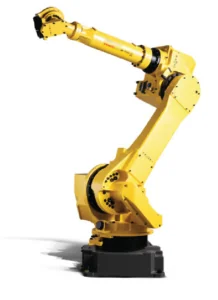
Introducing the client:
Stellantis Group is the fourth largest car manufacturer in the world. It consists of 14 car brands and its cars are sold in 130 countries of the world, with the largest customer being Europe (up to 49%). One of the plants of this company is located in Trnava, Slovakia.
Customer requirements:
- They wanted to create an eficient working environment on the production on the painting line.
- To solve the problems programming new trajectories for fully automated FANUC robots and checking the planned trajectory of the robots. In the case of incorrect configuration, there is a risk of damage of the bodywork and the robot effector or injury of the paint line operator.
- Removal of the time limitation for manually making possible adjustments to robots’ settings.
Description of the solution of DORPS, which came up with an innovative and effective solution:

Simulation and configuration environment
The creation of a 3D virtual twin of the FANUC painting robot
transferred to the real environment of the paint line through Microsoft Hololens 2 holographic glasses.
Enabling the operator to view the 3D model of the robot via MS Hololens 2 in a real environment with all program settings.
Enabling the verification of programmed trajectories by transferring data from the manufacturer's native configuration tool to the DEX solution.
Verification of the correct final parameters on the 3D models
of the robot, specific trajectories are then programmed onto the physical robots of the painting line.
Benefits of the simulation environment in DEX SW:
- An innovation in the production process compared to its alternatives.
- Maintaining the continuity of the production process - the operator no longer must interrupt the process for manual verification.
- Reduction of costs that may arise from damage of the bodywork or robots when the trajectory is incorrectly set.
- Increased safety at the workplace - the employee cannot be injured, as he is at a safe distance from the painting equipment.
- Increasing the comfort of employees when working with robots thanks to enough space to set the most eficient trajectory without the risk of error or injury - the whole process is less stressful for the employee.
Training environment
Based on a high workload of the painting line, it was also necessary to design a solution for the training processes of employees at the maintenance workplace of the paint line so that problems on the robots are eliminated as eficiently as possible.
Then a virtual paint line environment was created, by using the DEX SW solution and the holographic glasses.

In this environment, it is possible to insert a 3D model of the device, which the training process of workers takes place on. The training configuration process takes place in the administrative environment. Used descriptions, animations and various diagrams accompany them when performing maintenance on this virtual device. Considering the intensity of labor migration processes simulated in various language mutations are an essential part of the solution. In the form of a test included in the training process, the superior can monitor the level of learning of the trained employee.
Benefits of the training environment in DEX SW:
- Reduction of costs by EUR 25,000 per year - workers do not have to go to an external service and training workplace.
- "Learning by doing" - workers learn much faster by working directly with the given equipment and processes related to them.
- Acceleration of the entire training process - workers in the virtual environment can disassemble the entire device into parts and assemble it again.
- Increasing work efficiency - the employee is more quickly ready to participate in the real work process, feels more confident, and eliminates the number of mistakes that he could potentially cause.

“If the problem occurs, we need the maintenance technician to be able to solve it as efficiently as possible. He can train these things using Hololens 2 glasses and then use it in practice.”
Peter Ďuriš – maintenance technician Stellantis Group
Other expanding possibilities of the DEX SW solution for the Stellantis customer
1. Remote support, when simulating several robots on the line with the goal of time efficiency of the painting process or quality process management.
2. Inserting other 3D models and editing process scenarios based on their own process creation without depending on the supplier, which significantly helps to reduce the total costs of operating the solution (TCO).
3. Streamlining the process of programming and testing movements of FANUC robots:

Integration with the native configuration tool from the manufacturer for smooth transfer of configuration data of set trajectories with their visualization in 3D space.
Implementation of the effect of applying the varnish so that the spray beam of the paint against the body can be seen.
The possibility of transferring back the manually adjusted trajectory of the robot (by moving the arm of the 3D model of the robot in the real scene) to the manufacturer's configuration tool.
Connection of individual 3D models to the levels of trajectories so that work can be started by one employee and finished by another robot.